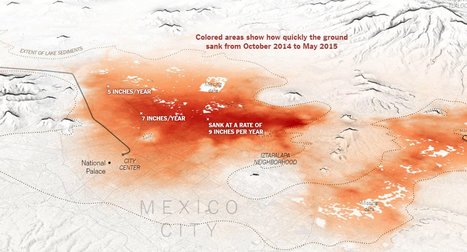"A host of environmental factors are threatening to push a crowded capital toward a breaking point."
Research and publish the best content.
Get Started for FREE
Sign up with Facebook Sign up with X
I don't have a Facebook or a X account
Already have an account: Login
 Your new post is loading... Your new post is loading...
 Your new post is loading... Your new post is loading...
|

Kelsey McIntosh's curator insight,
February 13, 2018 9:13 PM
In the Chiapas, Mexico there is a 16th century church that has been revealed due to the decrease in a reservoirs water level. This brief article is accompanied by pictures of the church that was abandoned in the 1770's do to the plague. According to the article, this is the second time the place of worship has been seen since 2002.

Olivia Campanella's curator insight,
September 19, 2018 10:53 AM
This 16th century church first emerged from the waters of the Nezahualcoyotl reservoir in the Southern Mexican state of the Chiapas. And since the reservoir was completed in 1966 with the waters dropping low enough to reveal the church for the 2nd time. The waters have dropped low enough in 2002 for people to actually walk inside and stand on.

Kelvis Hernandez's curator insight,
September 29, 2018 11:53 PM
"You go in the cage, cage goes in the water, you go in the water. Churches in the water, our church." At least I am pretty sure that's how the line from Steven Speilberg's 1975 thriller "Churches". This 16th-century church just emerged from the nezahualcoyotl reservoir in Mexico which hasn't occurred since 2002. The temple of Santiago was built by monks who came to Mexico around the late 16th century, but it was ultimately abandoned after being hit by the plague in 1773-1776. The drought in the area caused the water level to drop 82 feet. This being the second time water levels have revealed the church, in 2002 visitors were able to walk into the temple itself. 1 |












Urban ecology, environmental justice, gendered inequities, primate city politics, the struggle of growing megacities…it’s all here in this fantastic piece of investigative reporting. The article highlights the ecological problems that Mexico City faces (high-altitude exacerbates air pollution, interior drainage worsens water pollution, limited aquifers that are overworked lead to subsidence, importing water outside of the basin requires enormous amounts of energy, etc.). just because the article doesn't use the word 'geography' doesn't mean that it isn't incredibly geographic. All of these problems are at the heart of human-environmental nexus of 21st century urbanization.
Tags: urban, megacities, water, environment, Mexico.